Positive steps promote Nghe An’s economy
 |
| WHA Industrial Zone in Nghe An province’s Southeast Economic Zone |
In mid-December, Deputy Prime Minister Tran Hong Ha approved Nghe An province’s master plan for the rest of this decade and with a vision to 2050. Covering economic corridors, industries, urban centres, and more, the plan emphasises directions to help Nghe An promote its unique potential, outstanding opportunities, competitive advantages, and turn problems into advantages worthy of its strategic location and important role for the North Central region and beyond.
The goal is to build Nghe An into a well-developed province with fast and sustainable economic development, imbued with the cultural identity of Vietnam and the locality itself. It wants to become the centre of the region in terms of trade, health, education and training, science and technology, and high-tech industry and agriculture, while ensuring a synchronous, modern infrastructure system that adapts to climate change.
By 2030, Nghe An targets to achieve an average regional GDP of about 10.5-11 per cent annually. In the regional GDP structure, the proportion of industry-construction would account for around 42 per cent; services over 39 per cent; agri-forestry-fisheries account for up to 14 per cent, and product taxes minus product subsidies accounting for up to 5 per cent. Regional GDP per capita in 2030 is hoped to be $7,500-8,000.
By 2050, Nghe An will be a comprehensively developed, civilised, and modern province of the country and imbued with the cultural identity of Vietnam and Nghe An, as an important development driving force for the region.
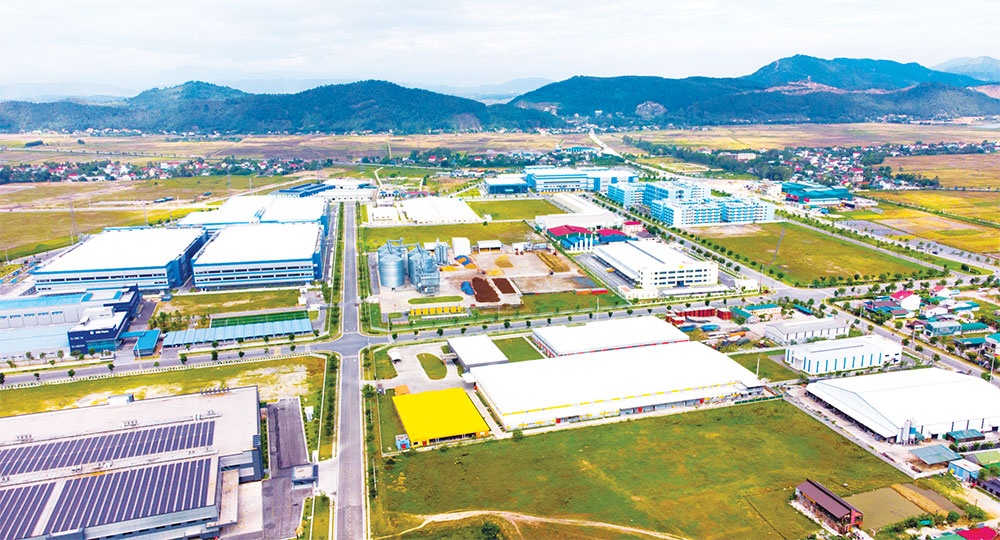 |
| Panorama of VSIP Nghe An |
Strategic milestones
To achieve these goals, the province needs to implement three strategic breakthroughs. First, Nghe An aims to synchronously perfect institutions and policies; strongly improve the investment and business environment with outstanding competitiveness associated with administrative reform; and strengthen decentralisation while promoting initiative, creativity, and responsibility at all levels.
At the same time, the province needs to focus on investing in building synchronous and modern infrastructure to meet development requirements. In particular, priority is given to strategic transport infrastructure, creating connectivity and spreading development.
Finally, Nghe An prioritises comprehensive development of human resources, science, technology, and innovation associated with promoting the cultural values and people of Nghe An. There will be a focus on education and training and attracting high-quality human resources.
The plan also guides the formation and development of four economic corridors. Specifically, it includes Ho Chi Minh Trail Economic Corridor; Economic Corridor National Highway No.7A; Economic Corridor National Highway No.48A; and the Coastal Economic Corridor associated with the National Highway No.1, the North-South Expressway’s eastern portion, and coastal roads, national railways, and sea routes.
Meanwhile, Nghe An looks to develop five pillar industries and fields. This includes supporting industries; industrial development, with a focus on processing and manufacturing industries; trade, services, education and training, and high-quality healthcare; developing high-tech agriculture; marine economic development associated with ensuring national defence and security; and tourism development. The latter area is based on cultural-historical tourism, resort tourism, marine entertainment and sports, ecotourism, and adventure tourism.
Regarding urban development, Nghe An will focus on investing in the Vinh urban area, the Hoang Mai urban area (developed in association with Quynh Luu), the Thai Hoa urban area (developed in association with Nghia Dan), the Dien Chau urban area, the Do Luong urban area, and the Con Cuong urban area.
Nguyen Duc Trung, Chairman of Nghe An People’s Committee, stated that the provincial planning towards 2050 has strategic significance, both as a premise and as a driving force to develop the province in the years ahead.
“Based on the planning, Nghe An will analyse, evaluate, and forecast the specific development factors and conditions of the province; evaluate the current state of socioeconomic development, current land use, and current status of urban and rural systems; assess the current state of infrastructure development; and build perspectives, identify goals, and select development options for the development of key industries,” Trung emphasised.
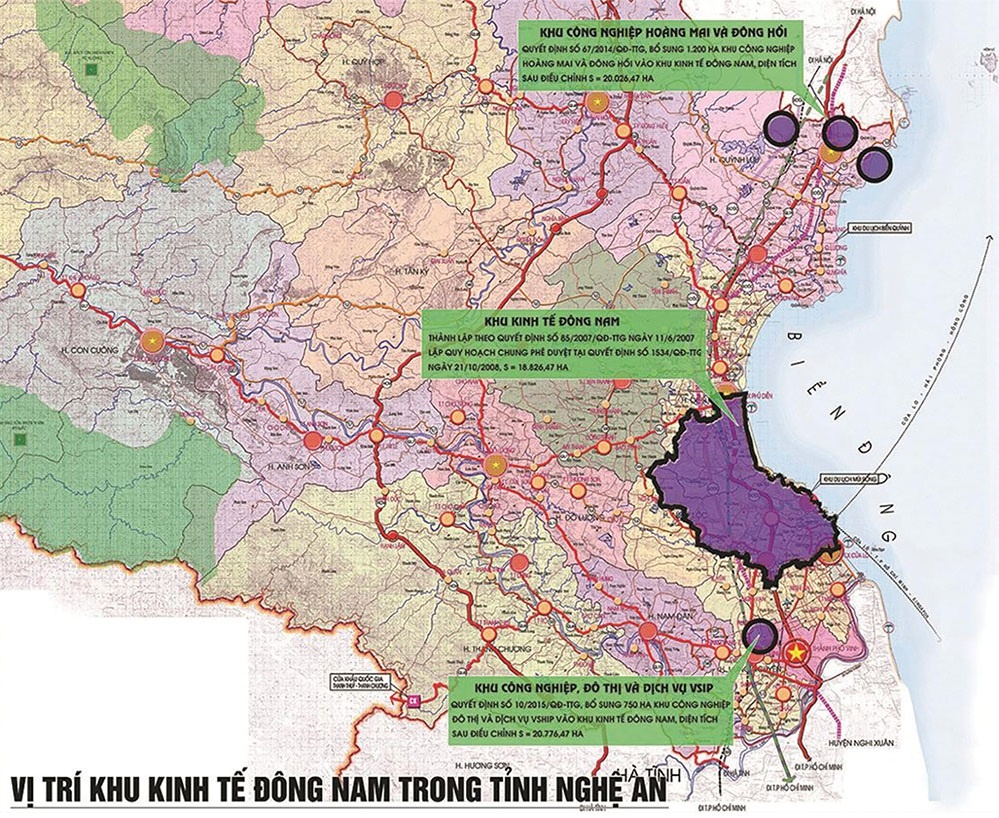 |
| The location of Southeast Economic Zone in Nghe An province |
Vital economic zone
In February, DPM Ha approved the overall adjustment of general planning for construction of Southeast Nghe An Economic Zone (EZ) towards 2040.
The EZ is a key, multi-industry, multi-sector zone covering almost 21,000 hectares. To attract investment and develop the EZ, in August Nghe An People’s Committee issued management regulations according to the overall adjustment project. Accordingly, it identified priority investment programmes and projects for the EZ during this period.
Le Tien Tri, director of the Management Board of Southeast Nghe An EZ, said that the local people’s committee has determined priorities to invest in the construction and completion of infrastructure in Vietnam-Singapore Industrial Park (IP) in the province as well as Nam Cam, Tho Loc, Dong Hoi, Hoang Mai I, and Hoang Mai II IPs to meet the demand for industrial land in the immediate period. It also seeks to attract investment in IPs to support seaport development combined with logistics and port logistics.
“In addition, the EZ will help form tourist service centres combining coastal urban areas from Tien Phong, Bai Lu, and Cua Hien beaches; invest in the construction of motivational projects to accelerate the development of urban area 3 in Nghi Yen commune, combined with a human resource training centre; and look for investment in tourism projects and golf courses in Xuan Duong lake area, Dien Trung commune, and Nghi Tien commune,” Tri explained.
At the same time, the EZ will prioritise the construction of housing development projects, meeting the needs of renovation and resettlement arrangements. There will also be the construction and renovation of shopping centres, exhibition fairs, cultural centres, and entertainment and sports parks.
According to Tri, Nghe An will promote the complete construction of the seaport technical infrastructure system, focusing on completing the construction of Cua Lo and Dong Hoi ports.
In particular, the EZ will focus on completing the coastal road running through the area; building a new road connecting the National Highway No.7C-N5 with Cua Lo North Seaport; and building a new road connecting the National Highway No.7A-Zone B of Tho Loc IP with the National Highway No.1A.
There also aims to be construction of line N1 and N2 connecting the National Highway No.1A and urban area 4, as well as a new tourist route connecting Xuan Duong Lake with Cuong Temple and Cua Hien.
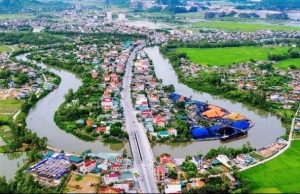 | Nghe An promotes development of Quynh Lap LNG-fueled power project The People's Committee of central Nghe An province has requested relevant departments, branches, localities and agencies to strictly implement assigned tasks to ensure quality and development progress of Quynh Lap liquefied-natural-gas (LNG)-fueled power project. |
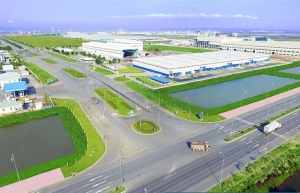 | Runergy increases investment in Nghe An Thailand-based Runergy PV Technology Co., Ltd. has adjusted the investment capital for its factory producing monocrystalline silicon rods and semiconductor platters in Nghe An province from $293 million to $440 million. |
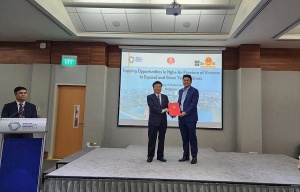 | Nghe An approves $45 million Singaporean factory system plan Nghe An People's Committee has awarded an investment certificate to Soilbuild Group Holdings to develop a system of ready-built factories and offices located in WHA Industrial Zone 1. |
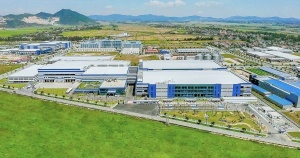 | Sunny Group to build $150-million factory in Nghe An China's Sunny Group has received an investment certificate to develop a $150-million factory in the central province of Nghe An. |
What the stars mean:
★ Poor ★ ★ Promising ★★★ Good ★★★★ Very good ★★★★★ Exceptional
Related Contents
Latest News
More News
- Global partnerships key to Vietnam’s IFC development (December 26, 2025 | 16:18)
- Vingroup pulls out of bid to invest in North-South high-speed railway (December 26, 2025 | 11:42)
- Strengthening supply chains through trade promotions and customs reform (December 24, 2025 | 14:00)
- PM orders investment model for North–South high-speed rail (December 22, 2025 | 17:43)
- LS Eco Energy to invest in Vietnam rare earth sector (December 22, 2025 | 17:31)
- Government moves to establish International Financial Centre (December 21, 2025 | 21:00)
- Vietnam's IFC to target global investment flows (December 21, 2025 | 18:00)
- Two national hospitals expand capacity with new facilities (December 20, 2025 | 09:00)
- Ha Tinh breaks ground on major Vingroup industrial and energy projects (December 19, 2025 | 18:24)
- EVN launches major power infrastructure projects nationwide (December 19, 2025 | 18:17)

 Tag:
Tag:





















 Mobile Version
Mobile Version